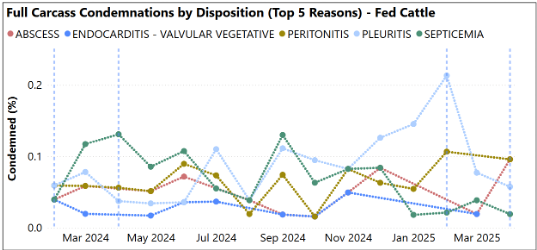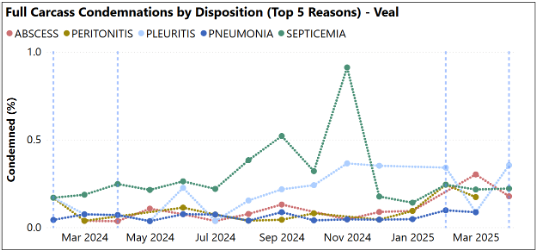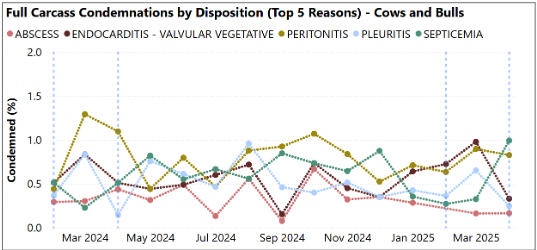Ontario Animal Health Network (OAHN) Bovine Expert Network Quarterly Veterinary Report
Q1 Bovine Data from the Animal Health Laboratory
A total of 1,677 bovine cases were submitted to the AHL during Q1, from Feb.1 to Apr. 30 2025. Of these, 177 submissions had a pathology component, consisting of 51 postmortem cases and 126 mail-in cases (including 40 meat inspection cases).
Regarding age distribution of the pathology cases (data often missing), 43 were young calves (under 2 months of age), 13 older calves (2 months to 2 years of age) and 31 adult cattle.
Regarding commodity (if provided): 57 dairy, 78 beef, remaining were unspecified.
Of these, there were 35 abortion/reproductive loss investigations: 15 idiopathic abortion, 8 bacterial abortions (Trueperella, Streptococcus, Listeria. E. coli, Salmonella), 7 IBR abortions (see page 2), 4 Neospora, 1 congenital anomaly.
Salmonella
In total, 201 bovine submissions had bacterial culture performed (non-milk), 21 submissions included S. Dublin PCR. Salmonella spp. were detected in 9 submissions.
- Salmonella Dublin – 4 submissions from 4 premises. (calf pneumonia, calf illness, septicemia/enteritis veal calf, 1 fecal sample screening healthy lactating animal)
- Salmonella Agona – 3 submissions (calf septicemia –mixed infection, acute death calf, pneumonia heifer mixed infection)
- Salmonella Anatum – 1 submission (abortion)
- Salmonella sp. – 1 submissions (veal calf diarrhea)
Bovine Viral Diarrhea Virus (BVDV)
In total, 58 submissions had BVDV testing of which 39 submissions included BVD PCR. 6 submissions had positive PCR tests: 5 screening of blood samples and 1 ear notch.
This summary has been compiled by Dr. Andrew Brooks, Animal Health Laboratory (AHL) from diagnostic submissions to the AHL Guelph and Kemptville locations.
Bovine IBR Abortion Summary
Dr. Tanya Rossi
In the first quarter of 2025, 6 Infectious Bovine Rhinotracheitis (IBR) abortion cases from 3 Ontario dairy farms were submitted to the Animal Health Laboratory. IBR is caused by Bovine Herpesvirus type 1 (BHV-1) which is endemic in Canada and is associated with respiratory disease, reproductive loss and infertility, and systemic disease in neonatal calves.
Consistent with previous case reports 1, all affected farms experienced multiple abortions occurring in mid-late gestation. Farm 1 experienced 6 midterm abortions, Farm 2 reported 8 abortions in 2 separately housed groups with no direct contact, and Farm 3 experienced 5 midterm abortions. Farms 1 and 2 were vaccinated against BHV-1 in the months before the abortions, but farm 3 had declined vaccination. History provided by Farms 1 and 2 indicates all abortions were from first calf heifers while Farm 3 did not provide information on dam age. This age association may suggest the heifers did not have a sufficient level of immunity to BHV-1 compared to older cows despite vaccination. All herds were housed indoors, Farms 1 utilized free stall housing, Farm 3 used a tied stall setup and Farm 2 used a mix of both. The farms were from different counties and did not report direct or indirect contact indicating these abortion storms were isolated events.
All fetal submissions underwent postmortem and histological examination, and were tested for BHV-1, Leptospira spp., Neospora caninum, Bovine viral diarrhea virus, Bovine coronavirus, and Bovine adenovirus via PCR. No gross lesions were reported on postmortem; however, histological examination of liver, lungs and other tissues revealed pathognomonic multifocal hepatocellular necrosis1, and rare necrotic foci in the lungs, spleen, and adrenal glands. No mixed viral infections were reported in any case, but cases from Farm 3 had concurrent mixed bacterial placentitis.
1.Kennedy PC, Richards WPC: The pathology of abortion caused by the virus of infectious bovine rhinotracheitis. Vet Pathol. 1964, 1: 7-17.
Interesting Reading
Copper and manganese levels are associated with infectious abortions, stillbirths, and early neonatal deaths in upper Midwest beef cattle herds from the Journal of the American Veterinary Medical Association Volume 263 Issue S1 (2025)
Retrospective analysis of abortion cases submitted to a veterinary diagnostic lab over 5 years
The study identified increased risk of infectious abortion with lower levels of fetal liver copper and higher levels of fetal liver manganese
Salmonella Agona
Recent discussions of the bovine expert network noted that Salmonella Agona has been showing up more frequently in the bovine data. Salmonella Agona is a serovar of Salmonella enterica that, while less commonly associated with cattle than serovars like Dublin or Typhimurium, has been implicated in both animal and human infections. S. Agona has been linked to several foodborne outbreaks in humans, often associated with contaminated cereals and meats, and has been detected in animal feed 1.
Although not as host-adapted to cattle as S. Dublin, S. Agona can still be isolated from bovine sources, particularly in environments with poor hygiene. It may cause enteric disease in calves and cows and contribute to fecal shedding in shared settings. Its ability to survive in dry environments and its occasional multidrug resistance make it a concern. It also causes infections in chickens, turkeys, swine, and small ruminants.
The detections in Ontario bovine samples are described below. There have been 10 detections to date with 6 from calves, 3 from mature cows, and 1 from an aborted fetus. While S. Agona is not among the most prevalent serovars in cattle, its role in cross-species transmission and foodborne illness highlights the importance of monitoring even less common serotypes in livestock systems.
2023
- 1 detection in deceased neonatal beef calf
2024
- 3 detections:
- Aborted dairy fetus (150 days gestation)
- 2 mo. deceased dairy calf with BRD, head tilt and ear droop; unresponsive to treatment
- Fecal sample from a lactating dairy cow
2025
- 6 detections:
- Postmortem swab from a dairy cow; total of 8 cows died
- 4-day old beef calf that presented with scours and recumbency, detected on culture from brain
- Calf died acutely (3rd on farm)
- Postmortem on first lactation heifers with BRD (co-detection with M.hemolytica)
- 2 fecal sample from calves with diarrhea (same farm but separate submissions 1 mo apart)
1. European Food Safety Authority (EFSA) and European Centre for Disease Prevention Control (ECDC), 2018. Multi-country outbreak of Salmonella Agona infections possibly linked to ready-to-eat food. EFSA Supporting Publications, 15, 1465E. doi:10.2903/sp.efsa.2018.en-1465
Global Surveillance Update
Asian longhorned tick
The Michigan Department of Agriculture and Rural Development (MDARD) reported its first detection of Asian longhorned tick (ALHT). The detection from Berrien County, located close to Lake Michigan in the Western part of the State, was found during routine tick surveillance efforts. The ticks can be spread by the movement of animals, people and equipment and have now been detected in 22 States, including other States bordering Ontario (New York, Pennsylvania, and Ohio). ALHT acts as a vector for the transmission of Theileria orientalis, a protozoan parasite that infects blood cells, causing anemia, jaundice, weakness and in severe cases, death.
For more information on ALHT and Theileria orientalis genotype Ikeda : Pest Alert: Asian Longhorned Ticks and Asian Longhorned Tick and Theileria Orientalis Ikeda: Current Thoughts and Understandings
New world screwworm
The New World screwworm (NWS) is currently experiencing a resurgence in Central America and Mexico. While eradicated from the United States in the 1960s, and from Central America by the early 2000s, recent detections in Mexico have prompted the temporary suspension of live animal imports through certain U.S. border ports. In response to the outbreak, the USDA has partnered with Mexico and other affected countries to combat the spread of NWS. This collaboration includes the use of sterile insect technique (SIT), which involves releasing sterilized flies to reduce the screwworm population.
New World Screwworm What You need to Know
Foot & mouth disease
Foot and mouth disease made an unexpected appearance in 2 European countries in 2025. On January 13, Germany reported a detection in 3 water buffaloes and applied stamping out measures. As of April 14, WOAH has reinstated Germany’s “FMD-free country where vaccination is not practiced” status. On March 7, Hungary reported a detection in dairy heifers located in close proximity to the Hungary-Slovakia border. On March 21, Slovakia reported confirmed FMD in cattle farms near the Hungary border. A total of 5 farms in Hungary and 6 farms in Slovakia were found to be positive with the last detection on April 17, 2025. Vaccination and zoning have been applied and control measures and monitoring continue at this time. The source is currently unknown.
For updates: Foot-and-mouth disease – European Commission
Avian influenza (Dairy)
In the last 30 days, there have been only 4 documented cases of HPAI in dairy cattle in the United States (2 California, 2 Arizona). This is dramatically decreased from the previous months. The National Milk Testing Strategy (NMTS) continues to progress with 23 States now having earned “Unaffected” status. Seven States (California, Nevada, Idaho, Arizona, Texas, Minnesota, and Michigan) remain “Affected” based on National plant silo monitoring, State-specific surveillance or recent reported animal test positive results. [Current to 23-July-2025]
Guidance for Cdn veterinarians: HPAI in cattle: Guidance for private veterinarians
Condemnations data from Ontario Abattoirs
The Q1 2025 data from provincial abattoir condemnations is highlighted between the blue dashed lines. Note – condemned % = number of animals with that condition / total animals slaughtered for the month. The top 5 conditions recorded for the figure period are displayed.



Malignant Catarrhal Fever 101
With increasing interest in small holder farming operations that potentially have multiple species in one facility or on one farm, veterinarians may be more likely to diagnose malignant catarrhal fever (MCF). The bovine network recently discussed this scenario and reviewed the disease for veterinary awareness.
Cause: In Ontario, MCF is typically caused by ovine herpesvirus-2 (OvHV-2). Sheep act as asymptomatic carrier species although clinical signs in sheep have been rarely reported. Weaned lambs are typically responsible for the highest amounts of shedding on farm.
Susceptible species: Cattle, water buffaloes, bison, and deer. Frequently in animals older than 1 year of age.
Transmission: Typically, by ingesting or inhaling OvHV-2 shed in sheep nasal, oral or eye secretions. Air transmission from sheep is possible. Cattle are dead-end hosts and do not transmit the virus to other cattle.
Signs: May include depression, fever, oculonasal discharge, oral or upper respiratory ulceration, ulcers on the feet, teats, vulva, or perineum, dyspnea, diarrhea, keratitis with corneal opacity, neurologic signs or sudden death may be observed without prior signs.
Diagnosis: Combination of clinical signs, potential herd history (direct or indirect contact with small ruminants), and lab testing
- PCR on EDTA blood or serum, or on postmortem collected lung, liver, spleen, kidney, lymph node or intestine is used for diagnosis.
- Serology can be used to detect latent infections in susceptible or carrier species but is not useful for clinical diagnosis.
FEB – APR 2025


